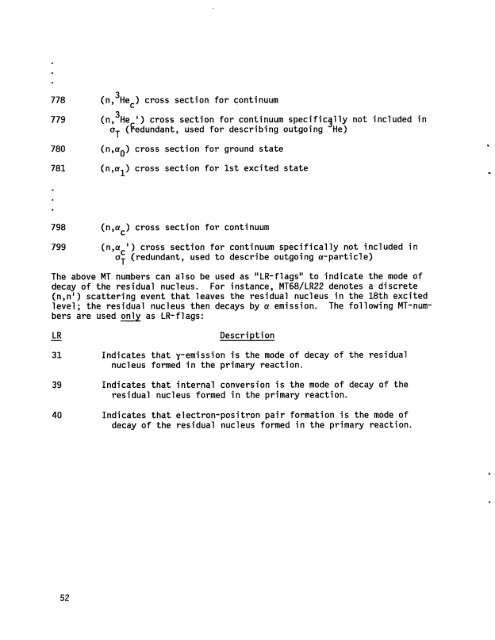The NJOY Nuclear Data Processing System, Volume 1:User's Manual
The NJOY Nuclear Data Processing System, Volume 1:User's Manual
The NJOY Nuclear Data Processing System, Volume 1:User's Manual
Create successful ePaper yourself
Turn your PDF publications into a flip-book with our unique Google optimized e-Paper software.
.<br />
.<br />
.<br />
778 (n,3Hec) cross section for continuum<br />
779 (n,3He ‘) cross section for continuum specific~lly not included in<br />
OT ($edundant, used for describing outgoing He)<br />
780 (n,aO) cross section for ground state<br />
781 (n,cil)cross section for 1st excited state<br />
.<br />
.<br />
.<br />
798 (n,ac) cross section for continuum<br />
799 (n,ac’) cross section for continuum specifically not included in<br />
CT (redundant, used to describe outgoing a-particle)<br />
<strong>The</strong> above MT numbers can also be used as “LR-flags” to indicate the mode of<br />
decay of the residual nucleus. For instance, MT68/LR22 denotes a discrete<br />
(n,n’) scattering event that leaves the residual nucleus in the 18th excited<br />
level; the residual nucleus then decays by a emission. <strong>The</strong> following MT-numbers<br />
are used ~ as LR-flags:<br />
LR<br />
—<br />
Description<br />
31 Indicates that y-emission is the mode of decay of the residual<br />
nucleus formed in the primary reaction.<br />
39 Indicates that internal conversion is the mode of decay of the<br />
residual nucleus formed in the primary reaction.<br />
40 Indicates that electron-positron pair formation is the mode of<br />
decay of the residual nucleus formed in the primary reaction.<br />
52<br />
*<br />
.<br />
.
















